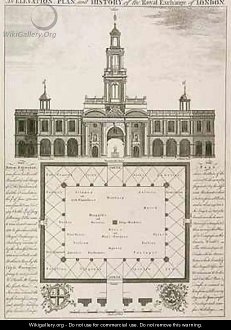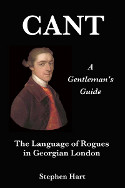London's Royal Exchange in the 18th Century

The following information is taken from London in 1731 by Don Manoel Gonzales. The complete text of this work is available at Project Gutenburg.
Introduction
The Royal Exchange we see today is not the same building described by Don Manoel Gonzales. In 1730 the Exchange building was the one built in 1669 after the Great Fire destroyed the original building. This building in its turn was burnt down in 1838 and not rebuilt until 1844.
Image from http://www.wikigallery.org/
Don Manoel's Account
The Royal Exchange is situated on the north side of Cornhill, about the middle of the street, forming an oblong open square, the inside whereof is a hundred and forty-four feet in length from east to west, and a hundred and seventeen in breadth from north to south; the area sixty-one square poles, on every side whereof is a noble piazza or cloister, consisting of twenty-eight columns and arches that support the galleries above.
The length of the building on the outside is two hundred and three feet, the breadth a hundred and seventy-one, and the height fifty- six. On the front towards Cornhill also is a noble piazza, consisting of ten pillars; and another on the opposite side next Threadneedle Street, of as many; and in the middle of each a magnificent gate. Over the Cornhill gate is a beautiful tower, a hundred and seventy-eight feet high, furnished with twelve small bells for chimes; and underneath the piazzas are capacious cellars, which serve for warehouses.
The whole building is of Portland stone, rustic work; above the arches the inward piazza is an entablament, with fine enrichments; and on the cornice a range of pilasters, within entablature, and a spacious compass pediment in the middle of the corners of each of the four sides. Under the pediment on the north side are the king's arms; on the south those of the City; and on the east the arms of Sir Thomas Gresham. And under the pediment on the west side the arms of the Company of Mercers, with their respective enrichments. The intercolumns of the upper range are twenty-four niches, nineteen of which are filled with the statues of the kings and queens regent of England, standing erect with their robes and regalia, except that of King James II. and King George II., which are habited like the Caesars.
On the south side are seven niches, of which four are filled, viz.:-
- The most easterly figure, which has this inscription in gold letters, Edvardus Primus Rex, Anno Dom. 1272
- Westward, Edvardus III. Rex, Anno Dom. 1329
- Henricus V. Rex, Anno Domini 1412
- Henricus VI. Rex, Anno Domini 1422
On the west side five niches, four of which are filled, viz.:-
- Under the most southerly figures is subscribed in gold letters, Edvardus IV. Rex, Anno Domini 1460
- Northward (the crown pendent over his head) Edvardus V. Rex, Anno Domini 1483
- Henricus VII. Rex, Anno Domini 1487
- Henricus VIII. Rex, Anno Domini 1508
On the north side seven niches are filled, viz.:-
- The most westerly, subscribed in golden characters, Edvardus VI. Rex, Anno Domini 1547
- Maria Regina, Anno Domini 1553
- Elizabetha Regina, Anno Domini 1558
- Is subscribed Serenissim & Potentissim' Princip' Jacobo Primo, Mag. Brit' Fran' & Hibern' Reg. Fid. Defensori, Societas Pannitonsorum posuit, A.D. 1684
- [Greek text which cannot be reproduced] Serenissimi & Religiosissimi Principis Caroli Primi, Angliae, Scotiae, Franciae Hiberniae Regis, Fidei Defensoris; Bis Martyris (in Corpore Effigie) Impiis Rebellium Manibus, ex hoc loco deturbata confracta, Anno Dom. 1647. Restituta hic demum collocata, Anno Dom. 1683. Gloria Martyrii qui te fregere Rebelles non potuere ipsum quem voluere Deum.
- Carolus Secundus Rex, Anno Domini 1648
- Jacobus II. Rex, Anno Domini 1685
On the east side five niches, one of which is vacant, the other filled, viz.:-
- The most northerly contains two statues, viz., of King William and Queen Mary, subscribed Gulielmus III. Rex, & Maria II. Regina, A.D. 1688. S. P. Q. Londin' Optim Principibus, P. C. 1695
- Anna Regina Dei Gratia Mag. Britan' Franciae & Hiberniae, 1701
- George I. inscribed Georgius D. G. Magnae Britan' Franciae & Hiberniae Rex, Anno Dom. 1714. S.P.Q.L.
- Southerly the statue of King George II. in the habiliment of a Caesar, wreathed on the head, and a battoon or truncheon in his hand, little differing from that of Charles II. in the centre of the area, only in looking northward; inscribed Georgius II. D. G. Mag. Brit. Fra. & Hib. Rex, Anno Dom. 1727. S.P.Q.L.
On the four sides of the piazza within the Exchange are twenty-eight niches, which are all vacant yet, except one near the north-west angle, where is the figure of Sir Thomas Gresham. The piazza itself is paved with black and white marble, and the court, or area, pitched with pebbles; in the middle whereof is the statue of King Charles II. in a Roman habit, with a battoon in his hand, erected on a marble pedestal, about eight feet high and looking southward; on which side of the pedestal, under an imperial crown, wings, trumpet of fame, sceptre and sword, palm branches, &c., are these words inscribed, viz.:-
Carolo II. Caesari Britannico, Patriae Patri, Regum Optimo Clementissimo Augustissimo, Generis Humani Deliciis, Utriusq; Fortunae Victori, Pacis Europae Arbitro, Marium Domino, ac Vindici Societatis Mercatorum Adventur' Angliae, quae per CCCC jam prope Annos Regia benignitate floret, Fidei Intemeratae & Gratitudinis aeternae hoc Testimonium venerabunda posuit, Anno Salutis Humanae 1684.
On the west side of the pedestal is neatly cut in relievo the figure of a Cupid reposing his right hand on a shield containing the arms of England and France quartered, and in his left hand a rose.
On the north side are the arms of Ireland on a shield, supported by a Cupid.
On the east side the arms of Scotland, with a Cupid holding a thistle all in relievo.
The inner piazza and court are divided into several stations, or walks, where the merchants of the respective nations, and those who have business with them, assemble distinctly; so that any merchant or commander of a vessel is readily found, if it be known to what country he trades. The several walks are described in the following ground-plot of the Exchange:-
0--North
+--------------------+ +------------------------+
| 1 2 | | 3 4 |
| +----------------+ +-------------------+ |
| | 7 8 9 10 | |
| 5 | 6 | 11 |
| | | |
| | | |
| | | |
| | | |
West| | +--------+ | | East
12 | | 13 14 | | 15 16 | | 17
| | | | | |
| | +--------+ | |
| | | |
| | | |
|18 | 19 | 20 |
| | | |
| | | |
| | | |
| | 21 22 | |
| +-----------------+ +------------------+ |
| 23 24 | | 25 26 |
+---------------------+ +-----------------------+
27--South
- Threadneedle Street
- East Country Walk
- Irish Walk
- Scotch Walk
- Dutch and Jewellers
- Norway Walk
- Silkmens Walk
- Clothiers Walk
- Hamburgh Walk
- Salters Walk
- Walk
- American Walk
- Castle Alley
- Turkey Walk
- Grocers and Druggists Walk
- Brokers, &c of Stocks Walk
- Italian Walk
- Swithin's Alley
- East India Walk
- Canary Walk
- Portugal Walk
- Barbadoes Walk.
- French Walk
- Virginia Walk
- Jamaica Walk.
- Spanish Walk
- Jews Walk
- Cornhill
Near the south gate is a spacious staircase, and near the north gate another, that lead up to the galleries, on each side whereof are shops for milliners and other trades, to the number of near two hundred, which brought in a good revenue at first, nothing being thought fashionable that was not purchased there; but the milliners are now dispersed all over the town, and the shops in the Exchange almost deserted.

